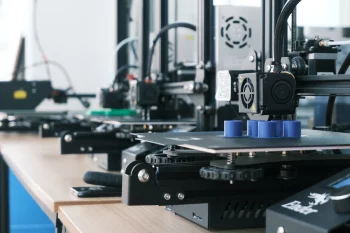When to Choose Additive vs. Subtractive Manufacturing for Your Prototype Model
Wondering when to use additive versus subtractive manufacturing for a prototype model?
You may have a preference about designing for one manufacturing method over the other. Perhaps your material choice or part geometry is only really suited for one of these applications. But having a bigger-picture understanding of both of these manufacturing methods can help you make informed decisions on a part-by-part basis. And those decisions may save time, reduce cost, or even bet you a better part.
Benefits and Considerations of Additive and Subtractive Manufacturing
At a fundamental level, additive and subtractive manufacturing work in opposite ways. Additive manufacturing consists of adding material one layer at a time to create a completed part. Subtractive manufacturing, aka CNC machining, consists of removing material from a large billet using CNC milling and turning centers.
The phrase additive manufacturing is most commonly used to refer to 3D printing. There are many 3D printing technologies available, including stereolithography (SLA), selective Laser Sintering (SLS), Fused Deposition Modeling (FDM), and Electron Beam Melting (EBM). These days, 3D printers can be found everywhere. Consumer 3D printers appear in homes and classrooms, while industrial 3D printers are used on factory floors.
Additive and subtractive manufacturing are each suitable for a range of applications in industries like electronics, medical, aerospace, and automotive. To determine which method is best for your prototype model, consider these key factors:
Cost
Unlike subtractive manufacturing, which may require expensive custom tooling, additive manufacturing is a tool-less solution. Manufacturers can produce parts using nothing more than a CAD model, a 3D printer, and the chosen material. This simple process eliminates tooling costs.
The cost of raw materials can be lower with additive manufacturing as well. Since 3D printers build parts layer by layer, clients pay only for the amount of material they need to create a prototype model. With subtractive manufacturing, the amount of material that will be removed must be factored into the original material purchase. However, the cost of the material itself can also vary between manufacturing methods.
For high-volume manufacturing, CNC machining (or an option like injection molding) is more cost-effective than 3D printing because once the tooling is in place, manufacturers can quickly create large quantities of parts. For prototyping, part complexity, which we’ll discuss shortly, can have a significant impact on part cost.
Lead Time
3D printing doesn’t require expensive tooling or setups, which makes it a relatively on-demand process compared to CNC machining. Depending on factors like size and complexity, it’s possible to build a complete part within just a few hours, which is ideal for rapid prototyping.
However, once work begins on the part, CNC machining is typically faster than 3D printing. If you have multiple parts in your run, even at low volumes, CNC machining may take less total time, even factoring in programming and setups. At KAD, we also leverage automation and “lights out” capabilities during CNC machining to further expedite prototype and production manufacturing.
Part Complexity
Additive manufacturing affords engineers a lot of leeway when it comes to part design. With 3D printing, it’s possible to produce extremely complex features that may be prohibitively expensive to machine. Adding complexity to prototype models is a great way to satisfy weight reduction requirements for parts in industries like aerospace, where every ounce of extra weight matters.
On the other hand, 3D printing capabilities may be overkill for more straightforward parts. And if complex features aren’t necessary to part functionality, CNC machining may be a better option. Keep in mind that all manufacturing processes have best practices when it comes to design; additive manufacturing may offer more design freedom, but it isn’t without limitations.
Quality Specifications
In terms of satisfying high surface finish requirements, subtractive manufacturing comes out on top. To achieve a smooth surface finish with 3D printing, parts must undergo post-processing operations such as media blasting and vapor smoothing. CNC machined parts may need secondary finishing as well, but in general, the surface finish is a much higher quality after the initial operations than with 3D printed parts.
CNC machining is also the better choice for parts with tight tolerance requirements because the setups can be programmed more accurately to meet those specifications.
Keep in mind that for prototype models, you may be able to compromise on surface finish or tolerance requirements. Many clients take advantage of the cost and time-saving benefits of additive manufacturing during early prototyping and then transition to subtractive manufacturing once they’ve proven their concept.
Material Requirements
Additive and subtractive manufacturing both support a wide range of materials, including hard and soft metals, nylon, and acrylic. But there are some material limitations for each manufacturing method. For instance, some 3D printers are the only choice for certain proprietary composite materials, and only CNC machines can work with wood.
Choosing the Right Manufacturing Method for Your Prototype Model
We recommend viewing your project holistically to determine the right manufacturing method for your prototype model.
Generally speaking, additive manufacturing is best when you need a cost-effective part fast—and if aesthetics and functionality aren’t major priorities. If, on the other hand, you need to conduct rigorous testing with an end-quality prototype model, subtractive manufacturing may better serve your needs.
In many cases, you won’t have to choose one or the other. Additive and subtractive manufacturing are complementary capabilities that can each be used in varying stages of product development—an approach known as hybrid manufacturing. During early prototyping, for instance, it’s common to use additive manufacturing for basic testing, then transition to CNC machining services to create finished parts.
No matter which manufacturing approach is ideal for your prototype model, KAD can provide the services you need. We conduct all subtractive machining in-house and work with a network of well-vetted partners for additive manufacturing services. Request a quote today!



